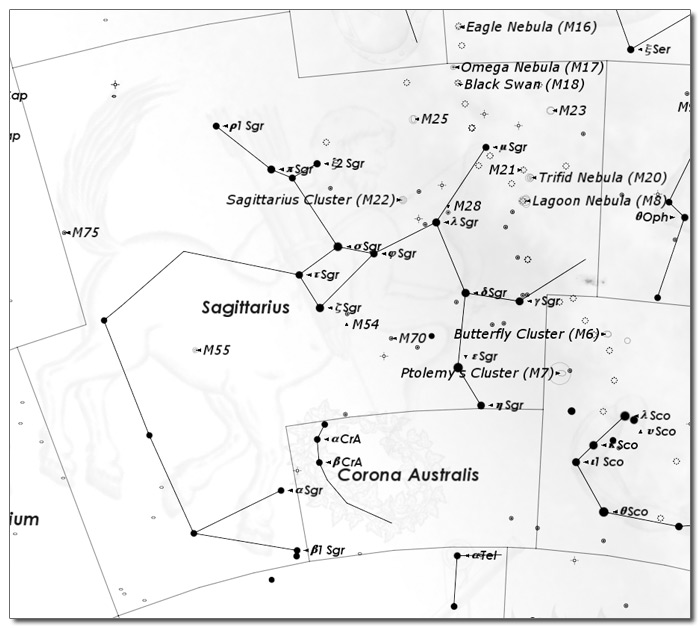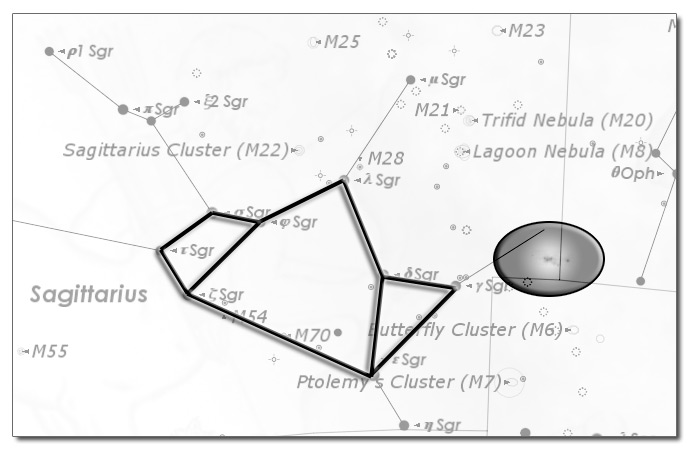As first appeared in the July 2009 edition of the Syracuse Astronomical Society newsletter The Astronomical Chronicle (PDF).
|
|
| Image generated with Starry Night Pro 6, www.starrynight.com. |
The Constellations, for all of their mythological, mystical, and ceremonial significance throughout human history, are also the bases for much of the scientific discovery (the Zodiac was a calendar long before it was ever used to identify the other kind of dates, and the backdrop of the unchanging Heavens served as the guide against which the motions of the planets were first tracked) that fueled our understanding of the universe before Edwin Hubble first exposed its true vastness by identifying the "Andromeda Nebula" as, in fact, a galaxy far outside of the Milky Way. The constellations have also served in a far more pragmatic capacity throughout human history as seasonal sign posts, simply marking times and locations for those on land and sea. Perhaps the most famous example of this in American History is the use of the Big Dipper as the marker by freed slaves traveling North along the Underground Railroad. The song "Follow the Drinkin' Gourd" is not simply a series of verses, but is instead a set of instructions, with the "Drinkin' Gourd" being the Big Dipper, the most easily recognizable asterism in the Northern Hemisphere (amateur astronomer or not) and pointer (by drawing an arrow from Merak to Dubhe) to the North Star Polaris, itself the most famous star of the Little Dipper (also known as Ursa Minor), an otherwise somewhat unimpressive constellation (certainly not as prominent in the North as the Big Dipper or the Cassiopeia "W" and, therefore, not as useful a sign post).
The Little Dipper is not the most prominent constellation in the Night Sky, but it serves as an important terrestrial marker because it includes Polaris among its member stars. Just as the Big Dipper is a prominent asterism that directs you to the Little Dipper, the Summer constellation Scorpius (which has been recognized specifically as a scorpion by many cultures for several millennia) can draw you to a slightly less prominent constellation to its West that is a sign post to a far more impressive marker than Polaris.
Sagittarius is an astronomy instructor's dream constellation, as it wraps up a number of interesting topics of discussion in one easy-to-find location. To begin, the Centaur, a half-human/half-horse hybrid, is the perfect bridge between the fantastical world of mythology in all of its seeming ridiculousness and, well, the shining example of what might even be ridiculously possible as scientists learn more about DNA and biological engineering (as of this past May, we now can make monkeys that glow in the dark. That's right, in the dark).
Second, Sagittarius provides its viewer another shining example of the difference between a constellation and an asterism. A constellation is, simply, a specific grouping of stars that everyone has agreed are, in fact, assigned to that particular constellation. This circular definition was finally laid flat by the International Astronomical Union in its defining of Constellation Boundaries, solidifying star groupings that go as far back as antiquity and as far forward as 1763 (the exploration of the Southern Hemisphere was not limited to the land and the sea). An asterism is, simply, a convenient grouping of stars that are NOT one of the 88 Official Constellations, with some asterisms being only fragments of a full Constellation (such as the Big Dipper, the most famous asterism in the Constellation Ursa Major) and some asterisms composed of parts of multiple Constellations (such as the Summer Triangle, composed of the stars Deneb (Cygnus), Altair (Aquila), and Vega (Lyra). At our latitude (Syracuse and Tully), we cannot even see the entire Constellation of Sagittarius, but have an excellent view during the Summer of one of the most modern of conveniences in the form of a Tea Pot (see below). We may seem a little ridiculous pointing out the tea pot, short and stout, with its handle (on the left or to the West) and its spout (on the right or to the East) at Darling Hill on a dark night, but you will not forget this asterism after it jumps out at you the first time. An important thing to remember is that any grouping of stars in the sky that helps YOU find what you are looking for is as significant an asterism as one you might find in any book. If an otherwise unlabeled grouping jumps out at you that helps you find your place in the Night Sky, put those informal naming rights to good use.
|
|
| Image generated with Starry Night Pro 6, www.starrynight.com. |
Third, the billowing steam from the spout of this tea pot marks a most important location to all 100 billion or more stars in our galaxy. The small darkened oval in the picture above marks the exact location of the center of the Milky Way galaxy (the tiny, fuzzy spec at its middle), meaning we are looking into the most dense region of the galaxy when we set our gazes at this region. Unfortunately, the city lights from Cortland wash the density of the Milky Way band at our South when we observe in Tully, although the full band of the Milky Way is prominent above us during the Summer.
|
|
| Images from ircamera.as.arizona.edu. |
Fourth, because we are looking into the heart of the Milky Way when we see the spout of the tea pot (as the image at right tries to show), we are looking into the densest region of stars we can see from Earth. As a result, this tea pot marks the location of a variety of Messier Objects and fainter nebulae far more numerous than even the largest variety pack the other Celestial Seasonings (pardon the tea pun) has to offer. The Trifid Nebula (M20), Lagoon Nebula (M8), Sagittarius Cluster (M22), Omega Nebula (M17), Black Swan Nebula (M18), M25, M23, M55, M54, M70, M28, M21, and M75 all reside within the Sagittarius boundary, while M6, M7, M16, and a host of other deep sky objects surround its borders in neighboring Scorpius, Ophiuchus, and Serpens Cauda.
When we observe during the Summer, I often recommend to new visitors with binoculars to simply point to the South, aim for the tea pot, and slowly scan. If your binoculars or telescope are anywhere near focused, you are guaranteed to find something within your field of view.
Mildly thirsty just thinking about it,
Damian
www.syracuse-astro.org
en.wikipedia.org/wiki/Constellation
en.wikipedia.org/wiki/Zodiac
www.match.com
en.wikipedia.org/wiki/Planets
en.wikipedia.org/wiki/Edwin_Hubble
en.wikipedia.org/wiki/Andromeda_Galaxy
en.wikipedia.org/wiki/Milky_Way
en.wikipedia.org/wiki/American_History
en.wikipedia.org/wiki/Big_Dipper
en.wikipedia.org/wiki/Underground_Railroad
en.wikipedia.org/wiki/Follow_the_Drinkin%27_Gourd
en.wikipedia.org/wiki/Northern_Hemisphere
en.wikipedia.org/wiki/Beta_Ursae_Majoris
en.wikipedia.org/wiki/Dubhe
en.wikipedia.org/wiki/Polaris
en.wikipedia.org/wiki/Little_Dipper
en.wikipedia.org/wiki/Cassiopeia_(constellation)
en.wikipedia.org/wiki/Scorpius
en.wikipedia.org/wiki/Sagittarius_(constellation)
en.wikipedia.org/wiki/Centaur
www.huffingtonpost.com/2009/05/27/glowing-baby-monkeys-marm_n_208296.html
www.engr.wisc.edu/wiscengr/feb02/monkey.shtml
www.examiner.com/x-9343-Denver-Health-Examiner~y2009m5d29-Monkeys-that-glow-in-the-dark
www.iau.org
en.wikipedia.org/wiki/List_of_constellations
en.wikipedia.org/wiki/Southern_Hemisphere
en.wikipedia.org/wiki/Asterism_(astronomy)
en.wikipedia.org/wiki/Summer_Triangle
en.wikipedia.org/wiki/Deneb
en.wikipedia.org/wiki/Altair
en.wikipedia.org/wiki/Vega
en.wikipedia.org/wiki/Sagittarius_(constellation)
en.wikipedia.org/wiki/Messier_20
en.wikipedia.org/wiki/Messier_8
en.wikipedia.org/wiki/Messier_22
en.wikipedia.org/wiki/Messier_17
en.wikipedia.org/wiki/Messier_18
en.wikipedia.org/wiki/Messier_25
en.wikipedia.org/wiki/Messier_23
en.wikipedia.org/wiki/Messier_55
en.wikipedia.org/wiki/Messier_54
en.wikipedia.org/wiki/Messier_70
en.wikipedia.org/wiki/Messier_28
en.wikipedia.org/wiki/Messier_21
en.wikipedia.org/wiki/Messier_75
en.wikipedia.org/wiki/Messier_6
en.wikipedia.org/wiki/Messier_7
en.wikipedia.org/wiki/Messier_16
en.wikipedia.org/wiki/Scorpius
en.wikipedia.org/wiki/Ophiuchus
en.wikipedia.org/wiki/Serpens_Cauda


